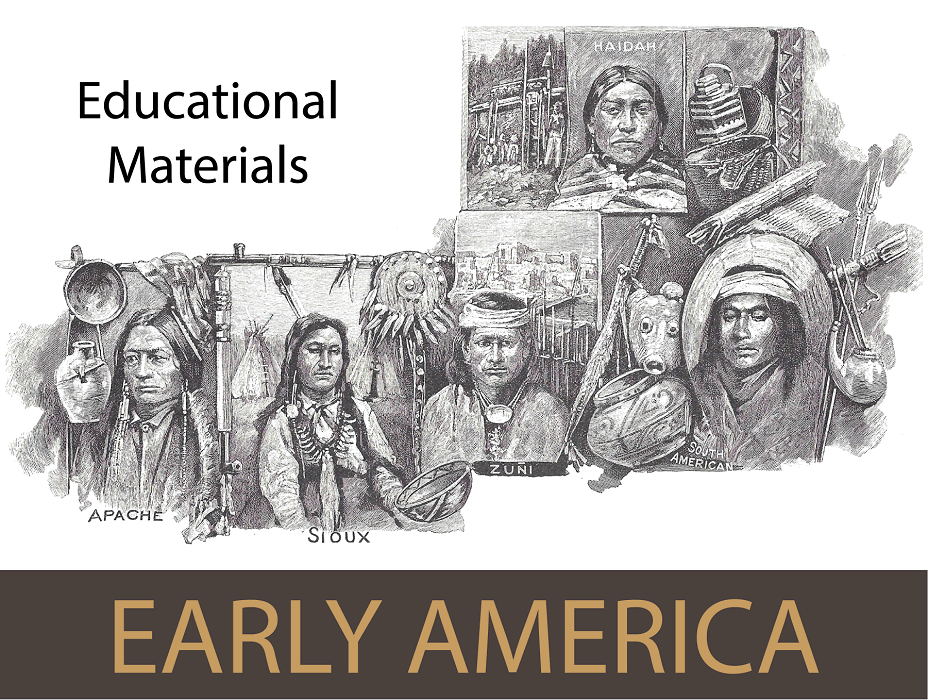 |
| Unit I: Early America |
|---|
| www.studenthandouts.com ↣ U.S. History ↣ Early America |
|
Early America Books and Films
Early America Image Galleries Early America Learning and Study Games |
Early America Miscellany
Early America Outlines and PowerPoints Early America Worksheets |
|
Before the arrival of European colonists, Native American societies in what is now the United States were diverse, with a wide range of cultures, languages, and traditions. It is important to note that Native American experiences varied greatly across regions, reflecting the environmental conditions and resources available in different areas. Here are some key aspects of life for Native Americans before the arrival of colonists. Diverse Cultures: Native American societies were highly diverse, consisting of hundreds of distinct tribes, nations, and groups, each with its own languages, customs, and social structures. These groups inhabited a variety of environments, from the arid deserts of the Southwest to the densely forested regions of the Northeast.  Lifestyles: Some Native American societies practiced subsistence lifestyles, relying on hunting, fishing, and gathering. Others developed sophisticated agricultural techniques, including the cultivation of maize (corn), beans, and squash, which formed the basis of their diets. Lifestyles: Some Native American societies practiced subsistence lifestyles, relying on hunting, fishing, and gathering. Others developed sophisticated agricultural techniques, including the cultivation of maize (corn), beans, and squash, which formed the basis of their diets.Sociopolitical Organization: Native American societies had complex sociopolitical structures. Some were organized into chiefdoms or confederations of tribes, while others had more decentralized systems of governance. Decision-making was often communal, with leadership roles based on merit, consensus, or heredity. Religious and Spiritual Beliefs: Native American religions were diverse, encompassing a wide range of beliefs and practices. Many Native Americans had deep spiritual connections to the land and nature. Animism, shamanism, and a reverence for ancestors were common elements of indigenous belief systems. Trade Networks: Native Americans engaged in extensive trade networks, exchanging goods, technologies, and cultural items over long distances. The exchange of goods facilitated cultural interactions and the spread of innovations. Diverse Housing: Housing styles varied widely among Native American groups. For example, Plains Indians lived in mobile tipis made from buffalo hides, while tribes in the Pacific Northwest constructed permanent longhouses. Adobe and stone dwellings were common in the Southwest. Art and Crafts: Native Americans were skilled artisans, creating a wide range of art and crafts, including pottery, textiles, jewelry, baskets, and carvings. These artistic traditions were often deeply connected to cultural and spiritual practices. Oral Traditions: Many Native American societies relied on oral traditions to pass down their history, myths, and cultural knowledge from one generation to the next. Storytelling and oral narratives were integral to preserving their heritage. Conflict and Alliances: Interactions among Native American groups were characterized by both cooperation and conflict. Tribes formed alliances for mutual defense or trade, but territorial disputes and competition for resources also led to conflicts. Impact of Epidemics: The arrival of European colonists had devastating consequences for Native American populations due to the introduction of new diseases, to which they had no immunity. These diseases, such as smallpox, decimated indigenous communities. Colonial Encounters: Initial encounters between Native Americans and European colonists varied in tone, ranging from cooperation to conflict. In many cases, colonists sought to exploit indigenous resources and exert control, leading to tensions and resistance. It is crucial to recognize that Native American history is not a monolithic narrative but a complex tapestry of diverse cultures and experiences. Native American societies had rich and vibrant civilizations long before the arrival of European colonists, and their legacies continue to shape the cultural, social, and political landscape of the United States today. |
| UNIT I: | Early America | UNIT IX: | Discontent and Reform | ||
| UNIT II: | Colonial Period | UNIT X: | War, Prosperity, and Depression | ||
| UNIT III: | American Revolution | UNIT XI: | New Deal and World War II | ||
| UNIT IV: | New National Government | UNIT XII: | Postwar America | ||
| UNIT V: | Westward Expansion | UNIT XIII: | Decades of Change | ||
| UNIT VI: | Sectional Conflict | UNIT XIV: | New Conservatism | ||
| UNIT VII: | Civil War and Reconstruction | UNIT XV: | Into the Twenty-first Century | ||
| UNIT VIII: | Growth and Transformation | UNIT XVI: | Polarization and Deglobalization |
| www.studenthandouts.com ↣ U.S. History ↣ Early America |








